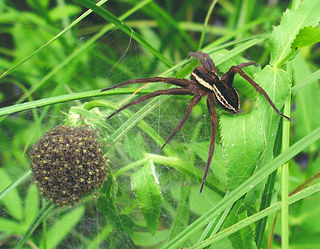
Dolomedes is a genus of large spiders of the family Dolomedidae. They are also known as fishing spiders, raft spiders, dock spiders or wharf spiders. Almost all Dolomedes species are semiaquatic, with the exception of the tree-dwelling D. albineus of the southeastern United States. Many species have a striking pale stripe down each side of the body.

Hadronyche formidabilis, the northern tree-dwelling funnel-web spider, is a medically significant mygalomorph spider found in Queensland and New South Wales. It is also known as the Northern Rivers funnel-web spider or northern funnel-web spider.

Barychelidae, also known as brushed trapdoor spiders, is a spider family with about 300 species in 39 genera.

Masteria is a genus of curtain web spiders that was first described by L. Koch in 1873. They occur in the tropics of Central to South America, Asia and Micronesia, with one species found in Australia. M. petrunkevitchi males are 4 millimetres (0.16 in) long and females are 5 millimetres (0.20 in) long. M. lewisi, M. barona, and M. downeyi are slightly smaller and have only six eyes. Most species in the genus have six eyes, but two have no eyes.

Dolomedes tenebrosus, known as the dark fishing spider, is a species of fishing spider found in the United States and Canada.

John (Jack) Burnett Venman was an Australian best known for deeding 254 acres of farming land to the Shire of Albert for A$1 in 1970. The land is now known as the Venman Bushland National Park. The park is located 40 km south of Brisbane CBD on West Mount Cotton Road, Mount Cotton, Queensland.

Megadolomedes is a genus of spider in the family Dolomedidae found in Eastern Australia. They are found near creeks, streams, and ponds, and are capable of running on water. Their diet includes small fish, frogs, and aquatic insects.

Dolomedes briangreenei is a species of fishing spiders found in Australia. The species name honours the physicist Brian Greene.

Megadolomedes australianus is a species of spider endemic to Australia in the family Dolomedidae. It was first described by Ludwig Carl Christian Koch in 1865.

Tamopsis is a genus of tree trunk spiders that was first described by B. Baehr & M. Baehr in 1987. Like other members of the family, they may be called two-tailed spiders, referring to two elongated spinnerets. The name is derived from the genus Tama and the Ancient Greek ὄψις, meaning "resembling".

Dolomedes schauinslandi or the Rangatira spider is a large spider of the family Dolomedidae. It is only found on South East Island (Rangatira), Houruakopara and Mangere Islands in the Chatham Islands, New Zealand. It is one of New Zealand's largest and rarest spiders.

Paraembolides is a genus of Australian funnel-web spiders that was first described by Robert John Raven in 1980.
Chenistonia is a genus of spiders in the family Anamidae. It was first described in 1901 by Henry Roughton Hogg. As of 2020, it contains 8 species, all from Australia.
Hickmanolobus is a genus of Australian araneomorph spiders in the family Orsolobidae, and was first described by Raymond Robert Forster & Norman I. Platnick in 1985.
Tasmanoonops is a genus of Australian araneomorph spiders in the family Orsolobidae, and was first described by V. V. Hickman in 1930.
Caledomedes is a genus of spiders in the family Dolomedidae containing the single species, Caledomedes flavovittatus. It was first described by Robert J. Raven & W. Hebron in 2018, and is only found in New Caledonia.
Ornodolomedes is a genus of Australian spiders in the family Dolomedidae first described by Robert J. Raven & W. Hebron in 2018.
Tasmomedes is a genus of spiders in the family Dolomedidae containing the single species, Tasmomedes eberhardarum. It was first described by Robert J. Raven & W. Hebron in 2018, and is only found in Australia.

Dolomedidae is a family of spiders comprising seven genera formerly part of the family Pisauridae. It includes the genus Dolomedes, known commonly as raft spiders, and its close relatives.

Megadolomedes trux is a species of spider endemic to Australia in the family Dolomedidae.












